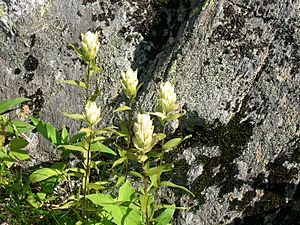Castilleja septentrionalis facts for kids
Quick facts for kids Castilleja septentrionalis |
|
|---|---|
 |
|
| Scientific classification | |
| Genus: |
Castilleja
|
| Species: |
septentrionalis
|
The Pale Painted Cup (scientific name: Castilleja septentrionalis) is a beautiful wild flower. It's also known by other names like northern painted cup, pale Indian paintbrush, and Labrador Indian paintbrush. This plant is a type of Indian paintbrush, which gets its name because its bright colors look like paint on a brush.
A botanist named Chris Mattrick once said that this flower's amazing beauty really stands out. It grows in rocky, green places in New England's mountains. People who see it often say how lovely it is!
Where It Grows
This special plant grows in northern areas or high up in the mountains. You can find it from Labrador and Newfoundland in Canada, all the way west to Alberta. In the United States, it grows from Maine to Utah.
In places like New Hampshire, the Pale Painted Cup is an alpine plant. This means it only grows in high mountain areas. It often lives in spots where a lot of snow stays on the ground late into the spring. This snow gives the plant water and protects it from harsh weather. The name "septentrionalis" actually means "northern," which fits where it likes to live!
Protecting the Plant
Because it's a special plant, some states are working to protect it.
- New Hampshire, Vermont, and Michigan list Castilleja septentrionalis as "Threatened." This means it could become endangered if we don't protect it.
- Maine calls it a "Special Concern" species.
- Minnesota considers it "Endangered," meaning it's at high risk of disappearing.
However, the United States government does not list it as a threatened species across the whole country.
What It Looks Like
The Pale Painted Cup is a perennial herb. This means it's a plant that lives for more than two years and comes back each growing season. It usually grows in small, thick groups.
Like many other Castilleja plants, it has a secret way of getting some of its food. It can get nutrients by connecting to the roots of other plants nearby. This is a bit like a plant borrowing food from its neighbors!
Stems and Flowers
The stems of the Pale Painted Cup usually don't have branches. They become a bit hairy near the top. Its leaves are simple and grow directly on the stem without a small stalk.
The flowers grow in tight bunches at the very top of the stems. Each flower cluster has small, tube-shaped flowers that are greenish-white. These flowers are surrounded by special leaves called bracts. These bracts are often cream-colored or have a purple tint, making the plant look very colorful and beautiful.

